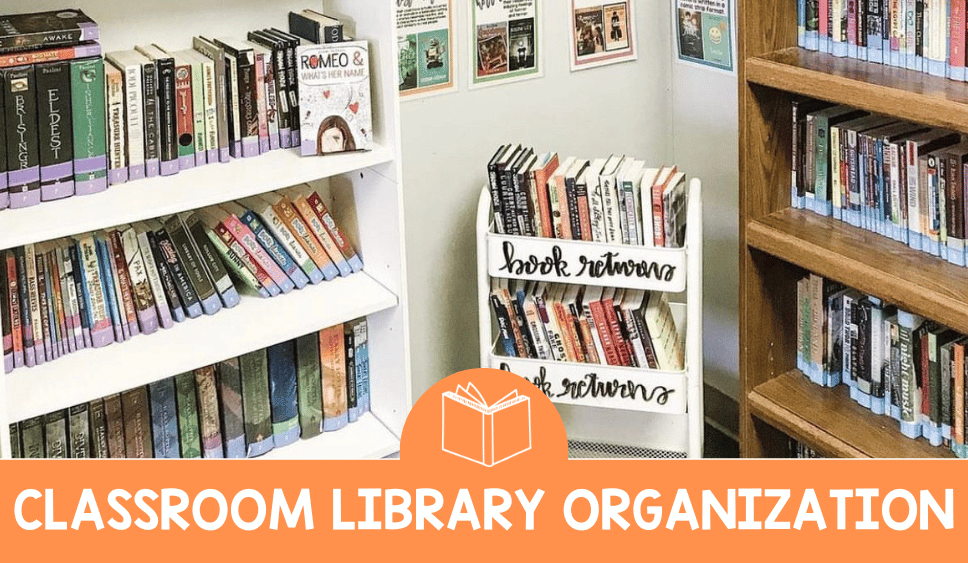

This middle school English teacher grading strategies for upper elementary and middle school grading and assessment blog post is part of a classroom organization series. This is part eight of ten blog posts all about how I organize different areas of my classroom. Click on any of the links to be taken to each of the posts in the series:
CLICK HERE to get the Organization Overhaul Complete Classroom Course plus bonus resources for each module.
CLICK HERE to get the complete printable organization E-Book.
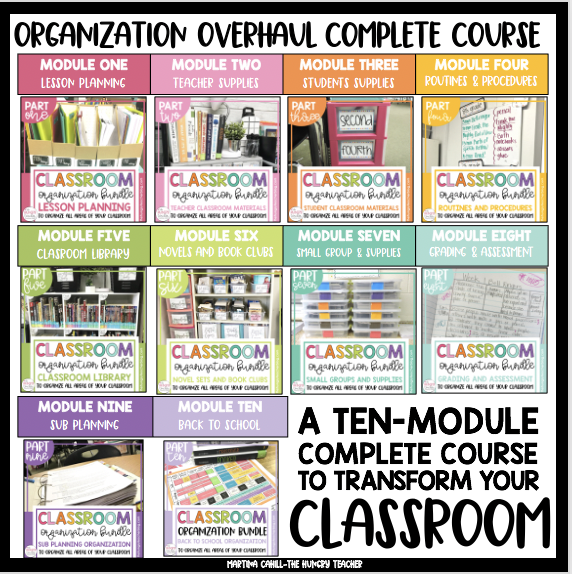
While my original classroom organization blog posts are popular, my guided reading and small group organizational series might be even more popular.
During my third year of teaching, and my first year in 6th grade, I wrote a blog post about doing small groups in middle school and middle grades. It quickly became my most popular blog post at the time.
Now, I am not an expert and parts of that year are such a blur, but I learned more in that one year, then I think I will for a long time, as a teacher.
I think the reason for it’s success was that I was like many other teachers out there. I was going through changes in life and as a teacher while trying to create routine and normalcy in areas of teaching that often lack these qualities (or at least are super difficult to create). Also, I was trying to do what some consider an elementary practice in a middle school setting. Even more so, I had a hint of self-depreciation as I struggled through the transition from elementary teacher to a kind of sort of middle school teacher.
I will outline many of my routines, procedures, and organization in the following pages, but you can also read the original three part series blog post through the links below:
This was my ELA routine (twice a day) when I taught sixth grade.You can get these editable small group schedule (no strings attached) by clicking here and downloading them.
After we do our ELA Bell Ringer and our Collections lesson, I do my first round of groups. It took A LOT of trial-and-error, A LOT of re-organization, and A LOT of flexibility on my part. After playing around with some stuff, this was the schedule I came up with. I had two 6th grade ELA classes.
Above I mention “Round 1” and “Round 2” when my students were doing Daily 5 and small group. This is a broken down schedule of what those groups looked like:
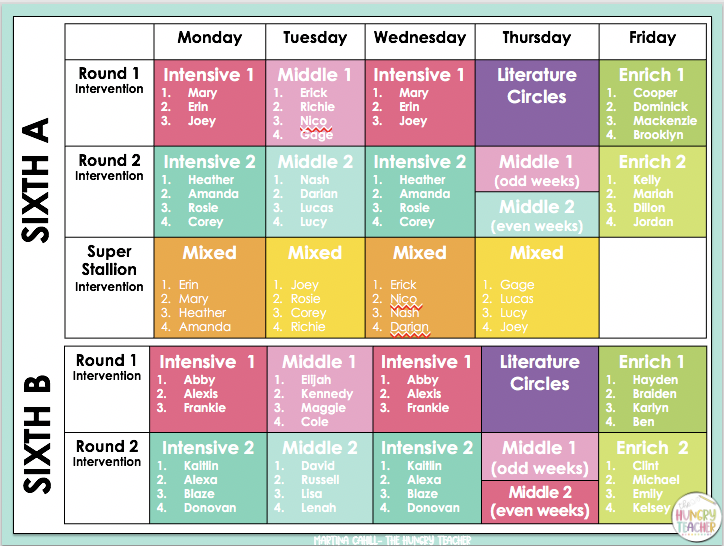

I wanted to meet with my intensive groups at least two times a week. That being said, I typically get to meet with them three times a week, because of our intervention block. This can change if I need to do assessments or work with other students at this time.
My proficient group meets with me about two times a week. In general, this is perfect. Sometimes, my proficient students need more help that week, and I just pull them to an intervention group or during Super Stallion/intervention time.
My enrichment groups only meet with me on Fridays. I used to feel guilty about this, but it’s perfect. They love that Fridays are devoted to them (sometimes, these kids, who get the least of my attention, just love to talk to me during this time). We get through as much as the other groups in just one session and most of them can multi-task. It really works out perfect.
I used to meet with literature circles every day to check in, but quickly realized that most of my middle schoolers don’t need me for this. For the ones that do, I just check in with them and support them during my small group time with them. ALL literature circle groups meet to discuss, check homework, and prepare for the week ahead on Thursdays. I just walk around, grade, and give support as necessary.
My literature circles and book clubs are outlined much more thoroughly in section six of this series.
What do the colors mean?
I started to really get in a groove with Guided Reading and small groups, but was SERIOUSLY struggling with the organization of the supplies. We had stuff in drawers, then bins, then file cabinets. It just wasn’t working because of the “Mixed Groups” section, and I would often move kids around for a variety of reasons.
We had a 30-minute intervention block at the end of the day where I had kids from all sorts of different groups. I could never find their individual supplies (meaning I had a kid from “blue A” and” purple B” and so on, all in one group).
I realized I needed them to be able to get their own stuff (duh!). The groups were color coded so I could tell them their color, and then when I met with them they were in charge of getting their stuff.
I went to Wal-Mart, bought these bins (but you can get them here on Amazon) and then color coded them as well. Now when I meet with a group, they just grab their bin, or a student can get their supplies out of their group’s bin.
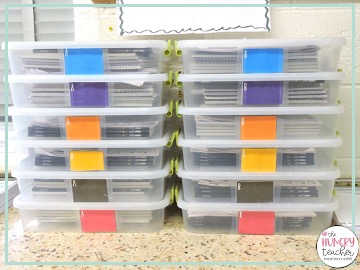

This was probably my number one question as an elementary teacher who went to middle school. With younger grades, you can typically read short books in one session, or maybe in a couple of sessions. The focus is on teaching students reading skills.
I still needed to teach this to some of my intensive groups, but in general, I needed to push my middle schoolers to think critically about their reading. I don’t get to see them as often each week, simply because middle school ELA classes tend to be 45-55 minutes. Some really lucky teachers get 90 minutes. Nonetheless, it’s not a lot of time to do it all, so in my current 55-minute classes I see groups once a week. I want the lessons to be focused, rigorous, and effective. I definitely don’t want the lessons dragged out for weeks on end.
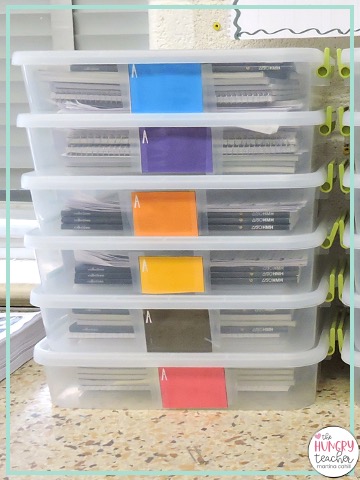

1. News articles that I print and we read and analyze (NewsELA.com has great ones).
2. Close reading passages: Keith Geswein, Kristine Nannini, Teaching and Tapas, and Lovin’ Lit on TPT are great for middle school passages.
I also have a couple of my own close reading passages based on my students’ interests: Anne Frank Close Reading and Al Capone Close Reading.
3. Task cards or exit slips focused on skills we need to work on. I have since made ELA exit slips for:
You can click on each link above or for the complete bundle click here.
You can also try ten of each exit tickets for free:
4. Reading response/writing quick writes. Students read a short story or article and either respond or are given a writing focused prompt. I have a blog post here about how I get through all my grading in class.
I have also since made a ton of different editable literature and reading response rubrics. Click here for the 6th-8th Grade Editable Literature Rubrics or click here for the 6th-8th Grade Editable Reading Response Rubrics.
5. Test prep. I am not a test prep person really, but the tests aren’t going away. I don’t believe in overkill in February, so I just sporadically choose some good test prep passages and questions for us to work on. We tend to have lots of authentic discussions about the tests, because we are in a small group like this.
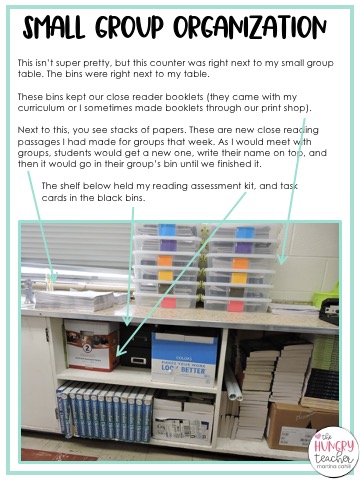

With small groups, I found that there were resources and tools that I was using constantly with all of my groups, I kept many of these resources within an arms reach or within a quick glance for students and I.
These “Evidence Based Terms,” and its corresponding chart paper were used almost every single day with almost every single group. We were always citing evidence and it made more sense for these to be right behind us for small group.
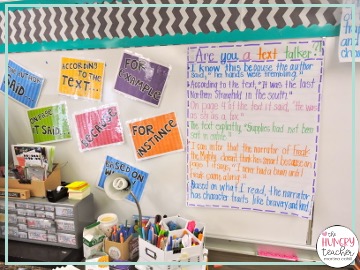

The posters are free in Leslie Ann’s TPT store, and I think I got the chart idea from The Creative Apple on her blog.
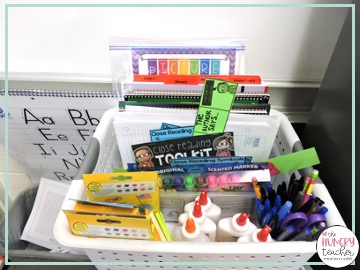

This was the bin that was always within arm’s reach of me at my group table.
It held writing utensils, my reading intervention strategies reference books, notebook paper, interactive notebook supplies, and our close reading tool kits.
It only held stuff for small groups which made it so I didn’t ever waste any time waiting for students to get what they would need for their tables/desks. I had everything we needed.
The close reading toolkits contained a variety of things from both The Creative Apple and Leslie Ann. Essentially, this was our go-to supply.
When kids came to the table they got a toolkit.
It usually contained 3 highlighters (for close reading), an evidence based terms bookmark, a close reading note guide, a *R.A.C.E bookmark, and a pen or a pencil.
*R.A.C.E – Restate the Question, Answer the Question, Cite Evidence, Explain the Evidence.
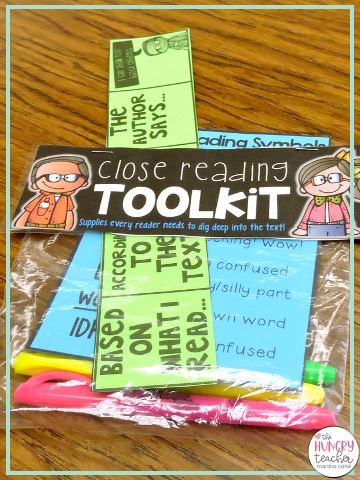

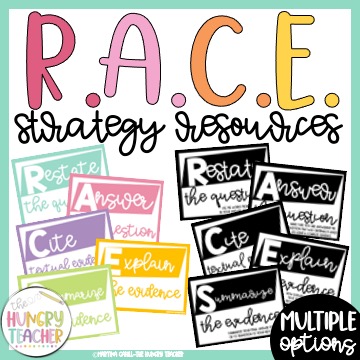

Over the years, I used the R.A.C.E. and R.A.C.E.S. strategy more and more in my classes.
My color schemes changed, and then I made posters and bookmarks to accompany that.
You can click here to get my R.A.C.E. strategy resource to be used in your classroom.
What are the rest of the kids doing?
When I taught 5th and 6th, the rest of the students had Daily 5 choices (we typically had just two rounds a day, but that worked perfect). The rounds were 15-20 minutes.
In 7th and 8th, my students can read or write while I am doing small groups. I only do one group a day and it lasts about 15 minutes.
As the year goes on, we will do Literature Circles and my 7th and 8th graders will have the choice to meet with their groups, or work on their literature circles homework at this time as well.
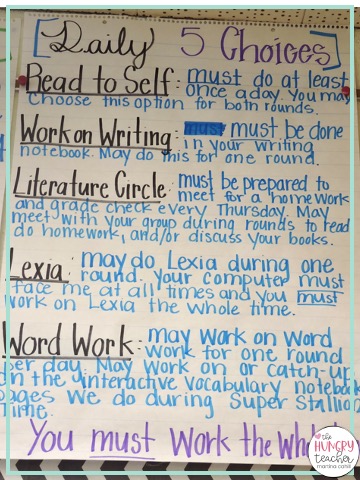


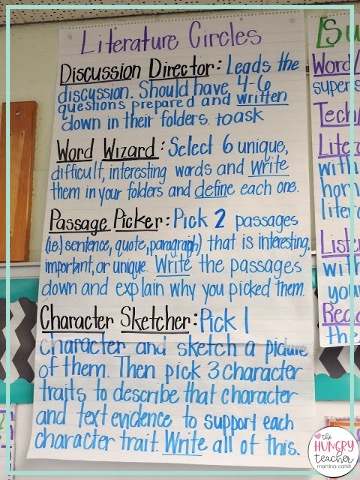


This is the chart we made in 6th grade to help students make sure they do their literature circle jobs each week.
I later made them packets to have the job descriptions, and eventually the jobs evolved with the groups.
However, I had some groups that needed a lot more structure and support, and we would sometimes work on their literature circles reading and homework during small group.
When I taught fifth grade self-contained, I just had a tab for each group I met with. When I went to sixth, I thought I would have a binder for each of my two classes, and then dividers for each group. The multiple binders situation just didn’t work for me.
My groups did fluctuate and move around a lot. I was always switching kids. This meant my “perfectly” labeled binders weren’t useful because they didn’t match the groups at all. I realized I needed more flexibility with my binders and with my forms for groups. The notes needed to drive my whole group and small group instruction. They also needed to be there to collect information about my students. It made sense that I just needed to find a system that worked for ME.
I went to one binder for both classes and labeled a tab for each day of the week. I could just flip to the day (instead of trying to find “the group”)
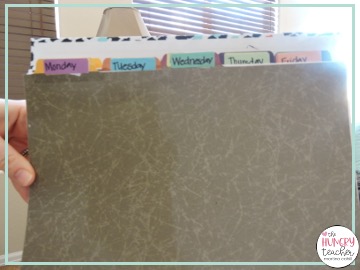

Then I made my notes SUPER generic and SUPER flexible. This allowed me to write the names in, write the lesson in, and then make notes about the groups.
On top I made a place for the date and place to circle whether it was 6A or 6B. I put two of these pages behind each day of the week, so I would have one for each of my two classes. I then would look at my notes at the end of the week, move kids around as needed. Then I make my new small group plans for the following week.
Then I would move these “old notes” into a larger binder for reference and put two new sheets behind the day of the week.
Now in 7th and 8th, I just have this same note-catcher.
It’s now two-sided with two groups on each side, because I have four classes where I meet with one group per day.
I just put one note-catcher behind each day of the week.
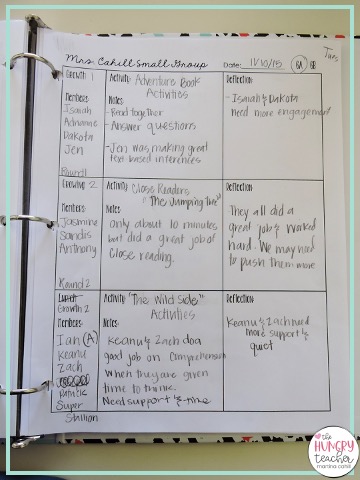

This is my more detailed note-catcher that I started to make as I realized that many of my students were still struggling with the same concepts. The super tiny words on the right-hand side is a checklist of skills specific students needed to work on. It helped make my small groups even more specific and needs based.
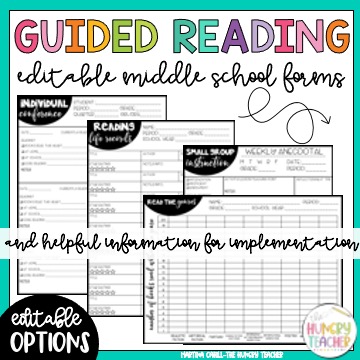

All of these forms are included in my guided reading resource specifically for middle school ELA.
CLICK HERE or on the image to get all these recording sheets and resources.
During my last three years as a teacher, I think my BIGGEST struggle has been teaching small groups. I don’t care what anyone says…. it is so hard. There are kids off task, middles schoolers being middle schoolers, fake reading, and 45 students asking approximately 4,593,678 questions a day while you are trying to teach your groups.
That being said, small group instruction is one of the most beneficial things I have ever done, and over time, you get better at preventing and managing the above scenarios. If you stick with it, and learn as you go, you won’t know how you ever taught without small groups before.
I typically have these amazing fantasy that I will start small groups by week 6 of school… bahaha… *full disclosure here*… it was more like week 12 for me. I used to feel guilty about this, but I don’t anymore. My first year, I didn’t really do small groups until week 26 maybe (ha!)
It takes time, practice, research, and patience, but over the last three years I have figured it out… kind of :).
The best thing I ever did was read Daily 5 and Reading in the Wild. These two books shape everything I do.
I do my best to explain it, but I highly recommend reading them (easy reads, so simple, and just common sense from both).
Again, my routine is almost all based on The Daily 5 and Reading in the Wild. The following will show you what works best for me.
Now if the creators of “Daily 5” came into my room, they probably wouldn’t call it “Daily 5,” but I do and this is what works in my middle school classroom.
After I teach my lessons, I then ask students what they are going to do, do a quick Status of the Class check. I simply ask them what they’re reading and what page they’re on. I write it all down, and they get started. While they work on these, I meet with my groups.
You can get free, editable Status of the Class forms by clicking here.
Students can choose from the following options during our Daily 5 rounds in sixth grade:



Students can read :). This is the only option they can choose for both of our rounds each day.
I believe it will NEVER hurt them if they choose to read for both of our rounds.
Some of my reluctant readers don’t choose this option at the start of the year, but this system allows me to work to put books in their hands so they slowly start to choose this option more frequently. I really try not to force anything.
Yes, I do still work ALL year long with some of my students to build up their love of reading, but it’s minimal and it’s just something I am ALWAYS working on with those students.
What students are doing:
I do literature circles very differently now, but this was how the structure worked when I taught sixth grade ELA.



This is a chart I made based on their roles. This is especially helpful for my sixth grade students who struggle with organization and remembering information.
I definitely do literature circles in so many different want but I do like to have forms for some groups.
When the pandemic hit, I also made sure to make digital versions, so students could still collaborate.
Click here or on the image to get the Literature Circle forms for middle school resource.
This is a computer literacy program our district purchased for us. It is self-paced.
I love this option because many of my reluctant readers choose this. (That’s not what I love it though! ha!). But it allows me to meet with my other kids at the start of the year and support them into being really independent.
I then can start slowly working with my reluctant readers to show them that books are better than a computer program.
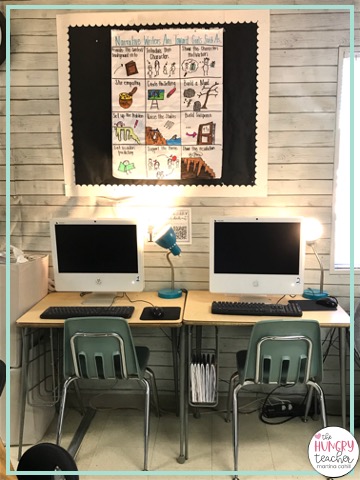

Many of these students could be a disruption at the beginning of the year.
This helps alleviate that, over time they get bored of the program and the novelty wears off, and I slowly get to try and build more readers. It’s just a good teacher tool for me to have.
When I went to middle school ELA, I used commonlit.org. In my opinion, it’s one of the best program for middle school ELA teachers.
Students can do the following activities during work on writing:
For writing workshop I use Kelly Anne’s Writing Workshop units. Writing is a different part of our day, but this is where I get my lessons, and where a lot of my students often get their ideas for their writing.
I wanted to explain what I do during my lessons and how they then lead into my small group time. I know this will not be helpful to all teachers, but I know that I like seeing how other classrooms and schedules work. It can often help me to figure out how I should set up my schedule.
I will start by revisiting my sixth grade ELA schedule. I was blessed with the ability to make the schedule I have, because I teach middle school in an Elementary School, so our kids only switch a few times a day.
Anyway, I have about 100-110 minutes with each class for ELA.


Why is my ELA block broken up like this?
Using the ideals of The Daily 5, I wanted my lessons broken up and my workshop time broken up.
Sixth graders are no better inclined to sit for extensive amounts of time than any other grade. I wish my lessons were even shorter sometimes, but in general, I work hard to keep them engaged and moving when I can.
The following section will outline what I do each class period.
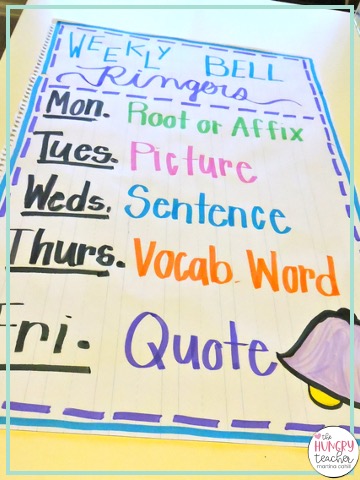

I have talked about bell ringers probably a million times. Here is a blog post all about how they changed my life. When I made them, my classroom routines were a mess and I was desperate for my ELA blocks to start out way better than they were.
I swear I am not product pushing when I say these bell ringers are the best thing I ever did. They are simple, routine-driven, and engaging.
My classes have been PERFECT ever since I started these.
My routines and procedures blog post talks more about bell ringers, and you can always try them free for three weeks:
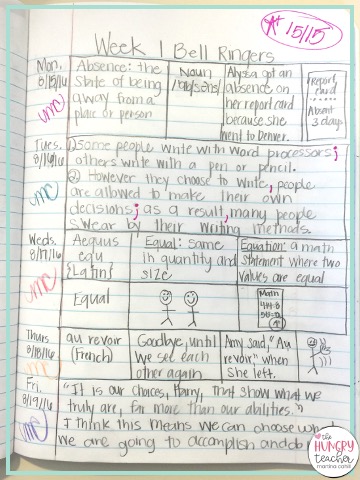

I have had to teach a bunch of different types of curriculums and my schedules reflect that. This was my schedule from sixth grade ELA. Again, Part Four of this series goes into much more detail.
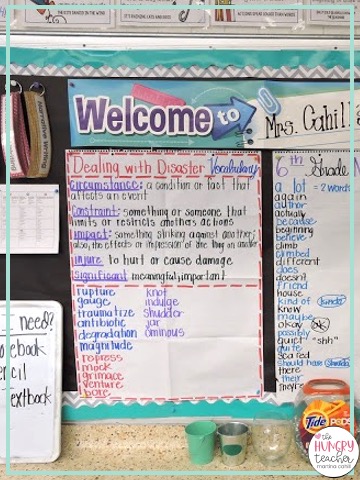

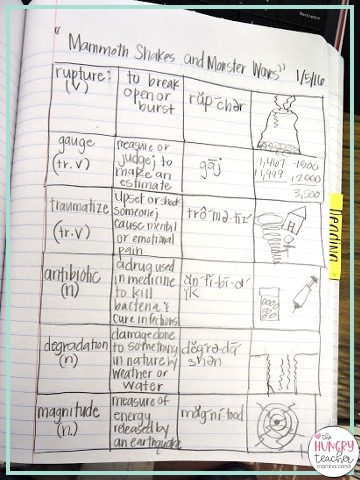

Story one vocabulary: We use the organizational structure below and we write, define, syllabify, and illustrate each word for the story before we read each one. They end up looking like the image to the left and we reference them throughout the whole story. They also always ace their vocabulary tests :).
Introduce the Demonstration of Learning/Essential question. I tell the students what I want them to be looking for or thinking about while we are reading.
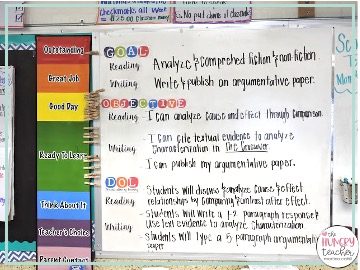

For example: What was the cause and three effects, using textual evidence, of the tsunami in the story?
I used to hate writing them on the board, but now I see the benefits. I mostly just have to change my Demonstration of Learning each day.
Listen to the audio of the story. I LOVE this. I ALWAYS read our novels, but I was getting so worn out reading the textbook and the novels for both of my classes. It’s so nice that they have audio for all of our stories. I just play it, andpause to talk about vocabulary and about evidence of the essential question. The best part about all of this is that I can read all the teacher notes on the side of the text, while the audio reads the story.
Demonstration of Learning Socratic Seminar: Basically we have a class discussion about the questions, I chart their responses on the board (example here), and then students write their answer in their notebooks.
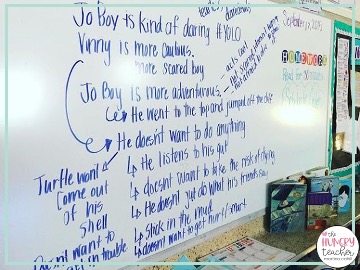

The board is to help students write strong responses by utilizing each other’s thinking. It’s basically a BIG collaborative discussion. I LOVE the Socratic Seminar and use it for everything.
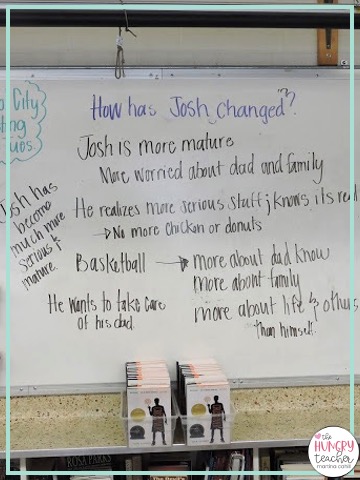

Comprehension and vocabulary test. Most of my students do REALLY well on these because we work on the story and vocabulary for 3-4 days.
Performance task (usually a writing analysis, media presentation, group presentation, or research/argumentative paper).
Then we go to the next story and start all over with the process. The time frame can change, (i.e. poems, teachable moments :), shorter/longer stories, and tougher performance tasks).
If you follow me and my teaching journey, you know I LOVE teaching with novels. At my previous school, I only used novels. I don’t have that freedom anymore, but I still use them as my second lesson of the day.
This middle school English teacher grading strategies for upper elementary and middle school grading and assessment blog post is part of a classroom organization series. This is part eight of ten blog posts all about how I organize different areas of my classroom. Click on any of the links to be taken to each of the posts in the series:
CLICK HERE to get the Organization Overhaul Complete Classroom Course plus bonus resources for each module.
CLICK HERE to get the complete printable organization E-Book.





My ELA scope and sequence guides break down every single middle school ELA standard and concept for reading, writing, and language in 6th, 7th, and 8th grade. Use the guides and resources exactly as is or as inspiration for you own!


I’m a Middle School ELA teacher committed to helping you improve your teaching & implement systems that help you get everything done during the school day!